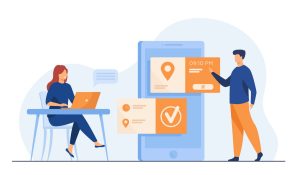
B2B appointment setting is a crucial component of every business strategy that aims to increase revenue and generate leads.
It includes reaching out to potential clients, speaking with decision-makers, and scheduling appointments for sales representatives to pitch their goods or services.
It becomes challenging to come up with effective B2B appointment setting solutions, especially in today’s fast-paced corporate environment, where decision-makers are sometimes swamped with competing offers and presentations.
Adopting efficient appointment-setting strategies is crucial to help firms maximize their chances of success.
In this blog, we’ll discover result-giving B2B appointment setting techniques so that firms can enhance their appointment setting processes and raise the likelihood that they’ll get appointments with prospective customers and close more deals. Ultimately, the business may have more successful sales and revenue growth.
What is B2B Appointment Setting?
It involves scheduling meetings between a business and potential clients or business partners. These meetings frequently involve showcasing products or solutions, investigating possible alliances, or discussing additional business opportunities.
When setting appointments for B2B transactions, a dedicated team of sales representatives or appointment setters frequently contacts potential customers by phone, email, or other means of communication to get B2B sales qualified leads.
They want to identify potential customers and set up meetings with decision-makers who genuinely want to learn more about what the business offers. But businesses should understand when they require appointment setting. So, let’s talk about the incidents when a company needs a B2B appointment setting.
When Should a Company Go for B2B Appointment Setting?
Setting B2B appointments should ideally be a crucial step in every deal conversion procedure. When the product team has created a precise demo of whatever product or service the brand intends to sell, that is when a firm should start launching appointment setting initiatives.
The following two situations can benefit the most from a B2B appointment setup.
1) Marketing high-priced B2B products
If your business specializes in large transactions or expensive services, sealing a sale likely involves several touchpoints and influencing many stakeholders through account-based sales (ABS).
B2B appointment setting campaigns should concentrate on identifying key decision-makers (KDM) while persistently following up with prospects until they are ready for a more involved pitch meeting to reduce the required work.
2) Very long sales cycle
In a complex B2B environment, a lengthy sales cycle is normal. By enabling the sales development representatives (SDR) to become involved as soon as the prospects are qualified and ready to buy, appointment setting aids brands in reducing the length of the sales cycle.
Closers have a great opportunity to advance the sales process because skilled appointment setters are well-versed in both inbound and outbound marketing techniques.
B2B appointment setting can’t be done effectively without preparation and proven methods.
Understanding Effective B2B Appointment Setting Techniques
By adopting these B2B appointment setting techniques, businesses can increase their chances of success. These techniques include defining your ideal customer profile, researching prospects, creating a compelling value proposition, leveraging technology, and adopting a personalized approach.

1) Make research your top focus
Research is the key to locating the greatest leads for your company. To be well-prepared for their qualifying interactions, appointment setters should take the time to investigate the potential buyers they are engaging with before reaching out to specific connections or bringing in a close salesperson.
This can boost self-assurance and provide information for the qualification process.
2) Concentrate on the right prospect from beginning
The most successful salesperson may place a higher priority on finding the ideal candidate while making a B2B appointment setting in order to close more deals. Because the improper prospects will prevent your campaign from being successful.
Decide who your ideal customers are before launching your appointment-setting campaign. What kind and size of business are you going after? You’re going to approach decision-makers at what level? Make a solid contact list with the appropriate individuals and phone numbers to save time.
3) Start looking for leads
It’s a crucial component in B2B appointment setting techniques. It’s time to start sourcing leads once you’ve determined your target client and have done adequate research.
In addition to cold calling, appointment setters should use social media sites like LinkedIn to look for prospects.
A potential lead is someone who has shown interest in your company or your service. Concentrate more on quality leads.
4) Create a lead nurturing campaign
Your appointment setting program won’t be viable without a B2B lead nurturing campaign. Prospects who reject a meeting must be continuously followed up with. Your efforts to set up a sales appointment will suffer if you call a prospect just once before giving up.
You can establish a strong rapport with your sales team by creating a B2B lead generation strategy. You have more opportunities to identify prospects’ pain points and provide them with value when you regularly interact with them.
5) Get contact details
Next, gather basic contact details from your leads to prepare for a phone call or email exchange. Look at their social media and the company website. Email and social media messages frequently elicit the best responses from leads, but it’s only sometimes the case. Speaking on the phone could be preferable when making more formal proposals.
6) Integrate Email Marketing Automation
A crucial B2B appointment setting technique is email marketing. You and your sales team can use B2B email marketing strategies to connect with KDMs and establish relationships, even though cold calling is still a successful appointment setting strategy.
If something goes wrong with their current B2B service provider, you can nurture leads and keep your business at the top of their minds by email marketing automation. Additionally, email automation enables you to send premium marketing materials that address potential clients’ problems and move them closer to the end of the sales cycle.
7) Schedule the Demo
It’s time to schedule a demo when your prospect qualifies as a lead. It is crucial to follow up and pick the best day for them because some target consumers frequently postpone appointments before agreeing to a meeting.
Also Read: Top 5 Data Challenges Today and How You Can Clear Them Out
When scheduling a meeting, please pay close attention to any issues or inquiries the lead may have, and let the sales team know about them before the meeting.
Remember to remind the prospective client of the appointment a day or two before.
8) Build a team of sales expert
B2B appointment setting requires a team of sales experts to handle specific tasks; one person cannot do it. You risk having an unsustainable cold-calling program and sales pipeline without a skilled B2B appointment setting team. Each team member is responsible for a specific task enabling your company to produce excellent outcomes consistently.
A successful B2B appointment-setting strategy advises hiring subject matter experts for the following positions on your sales team:
- Business development reps
- Sales development reps
- Account executives
- Customer service reps
- Sales executives
9) Collaborate with a high-performing appointment setting company
Setting appointment for B2B businesses is a difficult job. Many businesses lack the resources necessary to invest their time in starting and maintaining their appointment-setting efforts.
Many B2B businesses outsource their appointment setting efforts to concentrate on what they do best — running a business. When you work with a dependable appointment setting business, you can access top-performing sales professionals and all the technologies and tools you require to create a long-lasting sales pipeline. Your internal team can concentrate on making the ideal sales presentation while your external sales reps assist you in locating qualified leads.
10) Try to follow cold-calling best practices
Many businesses think cold calling is no longer effective, but we’re here to tell you that’s not true. Cold calling is still as effective as ever, and it is constantly changing to keep up with new technologies and tools for sales.
Making cold calls to potential businesses interested in your company’s products or services is a great way to establish rapport. Typically, a sales call is the first interaction between a company and a prospect, moving them along the sales pipeline. It is a common but valuable B2B appointment setting technique.
Summary
The success of an appointment setting campaign depends on several variables, which can be said after looking into different B2B appointment setting techniques. These elements include having a well-defined target audience, using a variety of communication channels, creating personalized messaging, and cultivating connections with prospects.
Ultimately, setting up B2B appointments necessitates a thorough understanding of the prospects’ goals and pain points. So, businesses must use data and analytics to track the effectiveness of their campaigns and make necessary changes by considering fruitful B2B appointment setting tips and strategies that work.
With the appropriate help from Binary Demand, you may become an expert in all the most B2B appointment-setting techniques!
FAQs
Q. Is it better to set appointments via cold calling or cold emailing?
A. Making a cold call might be more direct and personal. On the other hand, cold emailing can be less intrusive and make it easier for you to connect with more individuals.
Q. What should you do after setting an appointment?
A. After setting an appointment, these are the significant steps you should take:
- Verify the information
- Add the meeting to your calendar
- Add a reminder
- Getting ready for the appointment
- Show up on time
Follow up if required
Q. How and when should you send reminders?
A. You must pick the right time, use multiple channels, maintain a direct and to-the-point message, be respectful, and then follow up.
Q. What should you do immediately after your first client call?
A. You must first make notes, confirm the meeting, take the necessary action, and finally, be prepared for the meeting.
Q. Should you outsource appointment setting?
A. Depending on your company’s objectives and interests, outsourcing appointment setting might have benefits and drawbacks. So, a decision should be taken carefully.
Q. What is the best time to set appointments?
A. The ideal time to schedule an appointment in B2B is listed below:
- Avoid Mondays and Fridays
- Avoid early morning and late afternoon
- Schedule according to time zones
- Take into account the decision-makers’ schedule





